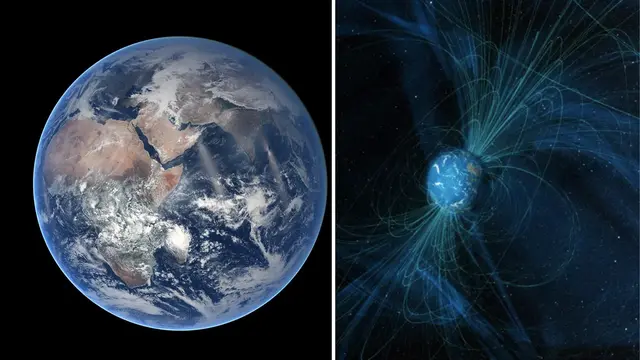Chinese scientists have sounded an alarm about the geomagnetic shield over North America, highlighting a rapid decline in magnetic field strength while the field appears to be strengthening over regions in the eastern hemisphere. This shift in Earth’s geomagnetic characteristics could have significant implications for global navigation, climate, and protection against cosmic radiation.
The research, led by Professor Fang Hanxian from the National University of Defence Technology in China, was published in the Review of Geophysics and Planetary Physics. Fang’s team utilized updated models and historical data to assess the changes in magnetic field strength across the globe since 1900, revealing a troubling trend over North America.
Findings: A Century of Change in Magnetic Field Strength
The study highlights that between 1930 and 1990, the magnetic field strength over North America saw an increase, reaching levels above many other regions worldwide. However, this trend has reversed dramatically over the last three decades, with the region’s magnetic field now barely holding above the global average. The rapid decline in the field strength has raised concerns among scientists and policymakers about potential implications for infrastructure, communication, and life on Earth.
Fang’s team noted that this decline became especially notable after the year 2000, with the field strength weakening at an unprecedented rate. “After 2000, the movement speed exceeded 50 km per year, far surpassing the movement speed of the magnetic pole in the southern hemisphere,” Fang remarked, emphasizing the concerning pace of change in recent years.
In contrast, areas in the eastern hemisphere — such as Australia, parts of Africa, and the North Atlantic Ocean — are experiencing an increase in magnetic field strength, signaling a geographical imbalance in Earth’s magnetic shield.

The Geomagnetic Shield: Earth’s First Line of Defense
Earth’s geomagnetic field, or magnetosphere, is a crucial protective layer that shields the planet from harmful solar winds and cosmic radiation. This field, generated by the motion of molten iron in Earth’s outer core, acts like a cosmic shield, deflecting charged particles and radiation from the Sun. This protective barrier is what allows Earth’s atmosphere to remain intact and supports the development of life, as opposed to planets like Mars, which lost its magnetosphere and subsequently most of its atmosphere.
The geomagnetic field is known to fluctuate over time, with poles shifting slightly in a process called geomagnetic pole reversal. However, significant, rapid shifts in field strength over large regions like North America are rare and could indicate underlying changes within Earth’s core dynamics. Such shifts could also influence atmospheric conditions, potentially impacting satellite communication, GPS systems, and even ground-based power grids.
Magnetic Pole Shift and Possible Causes
The magnetic poles have shifted over time, but recent shifts in the northward pole have been rapid, as the pole drifts eastward. Fang’s team attributes the accelerated weakening over North America and strengthening in the eastern hemisphere to this eastward shift of geomagnetic poles.
The team found that the northern magnetic pole has drifted eastward at an average rate of about 10 km per year over the last century. Such rapid movement could influence not only regional magnetic field strength but also global climate patterns, as geomagnetic fields interact with solar winds that influence atmospheric conditions.
Historical Impacts: Geomagnetic Field and Civilizational Changes
The effects of magnetic field changes on human history are not without precedent. For example, a 2018 study by the National Autonomous University of Mexico found that regions with weaker geomagnetic fields, such as the Maya area, experienced magnetic disturbances shortly before the civilization’s decline. Other studies suggest that similar magnetic fluctuations may have impacted ancient civilizations in Syria and Iran, potentially contributing to social and environmental stresses that led to their eventual downfall.
Broader Implications of a Weakening Field Over North America
While the current changes in the geomagnetic field are not an immediate cause for alarm, they do present potential risks to modern infrastructure. A weakened magnetic field over North America could expose the region to increased levels of cosmic radiation, potentially impacting high-altitude aviation and satellite-based communication systems. Additionally, solar storms could pose a higher risk to power grids and electrical systems in the affected regions, as the weakened magnetic field allows more solar energy to reach Earth’s surface.
According to Fang, understanding these changes is crucial as they may influence how humanity plans for future technological advancements and prepares for potential natural threats from space. With the United States being a leader in satellite technology and communication, researchers warn that a continued weakening of the magnetic shield could demand increased investments in radiation-resistant infrastructure.

Future Research and Monitoring Efforts
With these findings, scientists around the world are calling for more extensive monitoring and research into Earth’s magnetic field. The weakening of the geomagnetic shield over North America, as well as the strengthening over other areas, could help scientists better understand the Earth’s inner workings and improve predictions of geomagnetic pole shifts.
Fang’s team plans to continue their research, analyzing additional data to predict how the magnetic field will evolve in the coming years. Additionally, upcoming satellite missions could provide valuable data on Earth’s magnetosphere, enabling a more detailed understanding of these shifts. With ongoing studies and technological advancements, scientists hope to mitigate potential risks associated with geomagnetic changes and improve early warning systems for solar storms and other cosmic threats.
Navigating a New Geomagnetic Reality
The recent findings by Fang and his team highlight a critical shift in Earth’s magnetic environment, with North America potentially facing greater exposure to cosmic radiation due to a weakened geomagnetic field. While more research is necessary to fully understand the long-term impacts, this discovery serves as a reminder of the complex and dynamic nature of Earth’s protective magnetic shield. As scientists continue to monitor these changes, humanity may need to adapt to this evolving cosmic reality, balancing technological advancement with the protection that Earth’s magnetosphere provides.

